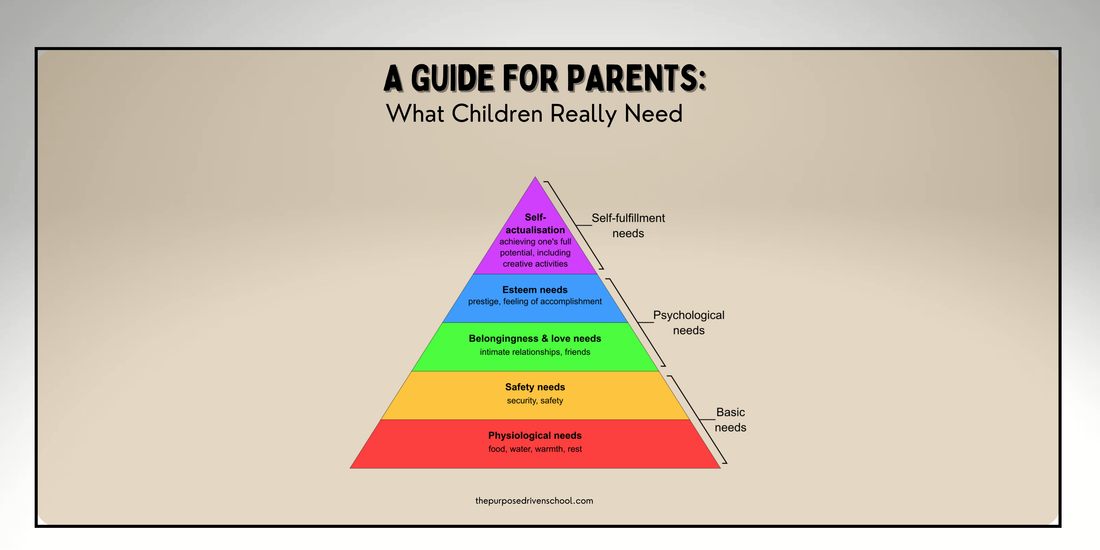Maslow's Hierarchy of Needs: A Guide for Parents :
What Children Really Need
By Shawn Brown
As parents, we constantly strive to provide the best for our children, especially when it comes to their education. But sometimes, understanding the broader picture of what our children truly need can be challenging.
What is Maslow's Hierarchy of Needs?
Developed by psychologist Abraham Maslow in 1943, the hierarchy is often depicted as a pyramid with five levels, each representing a different type of human need. The idea is that basic needs must be met before individuals can focus on higher-level growth. Here's a breakdown:
- Physiological Needs: Basic needs like food, water, sleep, and shelter.
- Safety Needs: Security, safety, and stability.
- Love and Belonging: Relationships, love, and connection with others.
- Esteem Needs: Respect, self-esteem, and recognition.
- Self-Actualization: Realizing personal potential, self-fulfillment, and personal growth.
So, how does this apply to parents in education?
1. Physiological Needs: The Foundation of Learning
Before your child can engage in learning, their basic physiological needs must be met. Imagine trying to concentrate on a math problem while you’re hungry or exhausted—it’s almost impossible. For children, this means:
- Nutrition: Ensure your child has access to healthy meals. A balanced diet can significantly impact concentration and energy levels.
- Sleep: Prioritize a consistent sleep schedule. Rest is crucial for brain development and cognitive function.
- Comfortable Learning Environment: Whether at home or school, your child needs a space that’s conducive to learning—free from extreme temperatures, loud noises, or other distractions.
2. Safety Needs: Creating a Secure Environment
Children need to feel safe both physically and emotionally to focus on their education. This involves:
- Physical Safety: Ensure that your child’s school is a safe place, free from violence or bullying. At home, maintain routines and a stable environment.
- Emotional Safety: Cultivate an environment where your child feels secure to express their thoughts and emotions. Let them know that it’s okay to make mistakes and ask questions.
3. Love and Belonging: Building Connections
Children thrive when they feel loved and accepted. This sense of belonging is critical for their emotional and social development:
- Family Relationships: Spend quality time with your child. Engage in activities that strengthen your bond, whether it’s reading together, playing games, or simply talking about their day.
- School Relationships: Encourage your child to build friendships and participate in group activities. A sense of belonging at school can boost their confidence and motivation to learn.
4. Esteem Needs: Nurturing Confidence and Respect
As children grow, their need for esteem becomes more pronounced. They seek recognition, achievement, and self-respect:
- Positive Reinforcement: Acknowledge your child’s efforts and achievements, no matter how small. Positive reinforcement can build their confidence and encourage them to take on new challenges.
- Encourage Independence: Allow your child to make decisions and take responsibility for their actions. This helps them develop a sense of self-worth and autonomy.
5. Self-Actualization: Supporting Your Child’s Potential
At the top of the hierarchy is self-actualization, where your child strives to reach their full potential. This is where their unique talents, interests, and dreams come into play:
- Encourage Exploration: Support your child in exploring their interests, whether it’s in academics, sports, arts, or other activities. Help them set goals and work towards achieving them.
- Foster Creativity and Critical Thinking: Provide opportunities for your child to think creatively and solve problems independently. Encourage them to ask questions and seek out knowledge beyond the classroom.
Applying Maslow’s Hierarchy as a Parent
Understanding and applying Maslow’s Hierarchy of Needs can help you better support your child’s educational journey. Here are some practical tips:
- Regular Check-Ins: Regularly assess where your child stands in the hierarchy. Are their basic needs being met? Are they feeling safe and connected? How is their self-esteem?
- Holistic Approach: Remember that education isn’t just about academics. It’s about supporting your child’s overall development—physically, emotionally, socially, and intellectually.
- Collaborate with Educators: Work with teachers and school staff to ensure that your child’s needs are being addressed in the classroom. Share insights about your child’s strengths, challenges, and needs.
Conclusion
As parents, we play a crucial role in helping our children navigate the different levels of Maslow’s Hierarchy of Needs. By ensuring their basic needs are met, fostering a safe and loving environment, and supporting their personal growth, we can help them achieve not just academic success, but a fulfilling and well-rounded life.
Remember, education is not just about grades—it’s about nurturing the whole child, and Maslow’s Hierarchy provides a valuable framework for doing just that.


